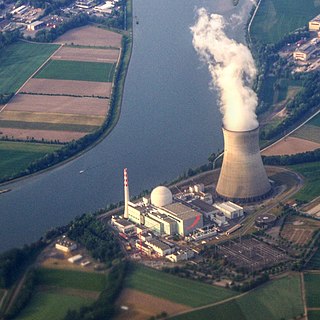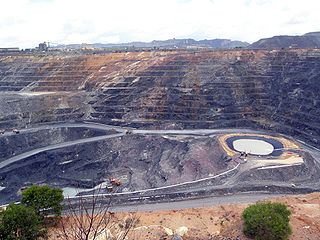
The CANDU is a Canadian pressurized heavy-water reactor design used to generate electric power. The acronym refers to its deuterium oxide moderator and its use of uranium fuel. CANDU reactors were first developed in the late 1950s and 1960s by a partnership between Atomic Energy of Canada Limited (AECL), the Hydro-Electric Power Commission of Ontario, Canadian General Electric, and other companies.

Nuclear power is the use of nuclear reactions to produce electricity. Nuclear power can be obtained from nuclear fission, nuclear decay and nuclear fusion reactions. Presently, the vast majority of electricity from nuclear power is produced by nuclear fission of uranium in nuclear power plants. Nuclear decay processes are used in niche applications such as radioisotope thermoelectric generators in some space probes such as Voyager 2. Energy production from controlled fusion power can potentially eliminate some resource restriction facing fission power, but it is not expected to be commercially availabe in the nearest future.
Enriched uranium is a type of uranium in which the percent composition of uranium-235 has been increased through the process of isotope separation. Naturally occurring uranium is composed of three major isotopes: uranium-238, uranium-235, and uranium-234. 235U is the only nuclide existing in nature that is fissile with thermal neutrons.

A non-renewable resource is a natural resource that cannot be readily replaced by natural means at a pace quick enough to keep up with consumption. An example is carbon-based fossil fuels. The original organic matter, with the aid of heat and pressure, becomes a fuel such as oil or gas. Earth minerals and metal ores, fossil fuels and groundwater in certain aquifers are all considered non-renewable resources, though individual elements are always conserved.

Areva S.A. is a French multinational group specializing in nuclear power headquartered in Courbevoie, France. Before its 2016 corporate restructuring, Areva was majority-owned by the French state through the French Alternative Energies and Atomic Energy Commission (54.37%), Banque publique d'investissement (3.32%), and Agence des participations de l'État (28.83%). Électricité de France, of which the French government has a majority ownership stake, owned 2.24%; Kuwait Investment Authority owned 4.82% as the second largest shareholder after the French state.

Rosatom, also known as Rosatom State Nuclear Energy Corporation, the State Atomic Energy Corporation Rosatom, or Rosatom State Corporation, is a Russian state corporation headquartered in Moscow that specializes in nuclear energy, nuclear non-energy goods and high-tech products. It was established in 2007 and comprises more than 350 enterprises, including scientific research organizations, a nuclear weapons complex, and the world's only nuclear icebreaker fleet.
The Megatons to Megawatts Program, also called the United States-Russia Highly Enriched Uranium Purchase Agreement, was an agreement between Russia and the United States whereby Russia converted 500 metric tons of "excess" weapons-grade uranium into 15,000 metric tons of low enriched uranium, which was purchased by the US for use in its commercial nuclear power plants. The official name of the program is the "Agreement between the Government of the Russian Federation and the Government of the United States of America Concerning the Disposition of Highly-Enriched Uranium Extracted from Nuclear Weapons", dated February 18, 1993. Under this Agreement, Russia agreed to supply the United States with low-enriched uranium (LEU) obtained from high-enriched uranium (HEU) found to be in excess of Russian defense purposes. The United States agreed to purchase the low-enriched uranium fuel.
A nuclear fuel bank is reserve of low enriched uranium (LEU) for countries that need a backup source of LEU to fuel their nuclear reactors. Countries that do have enrichment technology would donate enriched fuel to a "bank", from which countries not possessing enrichment technology would obtain fuel for their power reactors.

In the United States, nuclear power is provided by 94 commercial reactors with a net capacity of 97 gigawatts (GW), with 63 pressurized water reactors and 31 boiling water reactors. In 2019, they produced a total of 809.41 terawatt-hours of electricity, which accounted for 20% of the nation's total electric energy generation. In 2018, nuclear comprised nearly 50 percent of US emission-free energy generation.

Since the mid 1980s, the largest source of electricity in France has been nuclear power, with a generation of 379.5 TWh in 2019 and a total electricity production of 537.7 TWh. In 2018, the nuclear share was 71.67%, the highest percentage in the world.

Uranium mining is the process of extraction of uranium ore from the ground. Over 50,000 tons of uranium were produced in 2019. Kazakhstan, Canada, and Australia were the top three uranium producers, respectively, and together account for 68% of world production. Other countries producing more than 1,000 tons per year included Namibia, Niger, Russia, Uzbekistan, the United States, and China. Nearly all of the world's mined uranium is used to power nuclear power plants. Historically uranium was also used in applications such as uranium glass or ferrouranium but those applications have declined due to the radioactivity and toxicity of uranium and are nowadays mostly supplied with a plentiful cheap supply of depleted uranium which is also used in uranium ammunition. In addition to being cheaper, depleted uranium is also less radioactive due to a lower content of short-lived 234
U and 235
U than natural uranium.

World Nuclear Association is the international organization that promotes nuclear power and supports the companies that comprise the global nuclear industry. Its members come from all parts of the nuclear fuel cycle, including uranium mining, uranium conversion, uranium enrichment, nuclear fuel fabrication, plant manufacture, transport, and the disposal of used nuclear fuel, as well as electricity generation itself.
Techsnabexport, internationally known as TENEX, is an overseas trading company owned by Russian state-owned company Rosatom. Techsnabexport is an exporter of enriched uranium and a supplier of nuclear fuel cycle products.

National Atomic Company Kazatomprom Joint Stock Company (Kazatomprom) (Kazakh: Қазатомөнеркәсіп, romanized: Qazatomónerkásip) is the world’s largest producer and seller of natural uranium, providing over 40% of global primary uranium supply in 2019 from its operations in Kazakhstan. Kazatomprom's uranium is used for the generation of nuclear power around the world.

Nuclear power construction costs have varied significantly across the world and over time. Large and rapid increases in costs occurred during the 1970s, especially in the United States. Recent cost trends in countries such as Japan and Korea have been very different, including periods of stability and decline in construction costs.
Nuclear power is the fifth-largest source of electricity in India after coal, gas, hydroelectricity and wind power. As of November 2020, India has 23 nuclear reactors in operation in 8 nuclear power plants, with a total installed capacity of 7,380 MW. Nuclear power produced a total of 43 TWh in 2020–21, contributing 3.11% of total power generation in India. 10 more reactors are under construction with a combined generation capacity of 8,000 MW.

The Energy in Russia is an area of the national economy, science, and technology of the Russian Federation, encompassing energy resources, production, transmission, transformation, accumulation, distribution, and consumption of various types of energy.

Radioactive ores were first extracted in South Australia at Radium Hill in 1906 and Mount Painter in 1911. 2,000 tons of ore were treated to recover radium for medical use. Several hundred kilograms of uranium were also produced for use in ceramic glazes.
Reprocessed uranium (RepU) is the uranium recovered from nuclear reprocessing, as done commercially in France, the UK and Japan and by nuclear weapons states' military plutonium production programs. This uranium makes up the bulk of the material separated during reprocessing.

Centrus Energy Corp. is an American company that supplies nuclear fuel for use in nuclear power plants and works to develop and deploy advanced centrifuge technology to produce enriched uranium for commercial and government uses, including for national security.















